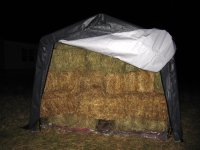Not very tech competent when it comes to posting pics. The floor looks like a regular concrete floor with a non-slip surface, not smooth polished.
Put a vapour barrier below your crushed limestone and with a 10% cement stabiliser with compaction on laying you will get a very hard stable, no hay shed floor that after opportunity for the compacted limestone to dry out will give a very serviceable waterproof floor. As far as a lot of work , I took it easy except for one day when I laid 2 panels ie 25 feet x 25 feet. Machines did most of the work, front end loader and plate compactor. The most difficult parts were using a 12 foot long screed board to level the material by myself (not having a power screed) and then troweling on the surface slurry of cement.
I had to use the material available locally. Crushed limestone is the material of choice in limestone belts for roadbase etc but I have about 60 miles to 100 miles to get limestone. The area here is in a granite belt.
The granite criusher dust as would limestone sets reasonably hard but the top layer will always dust up and come loose, hence the admixture of cement to stop any dusting up with the mechanical action of tyres.
After my comment about snakes not being an issue, on 30 December when at my hay shed there was a "banded gwardar" (also spelt gwarder) of about 1.2 metres or 4 feet long. Gwardars come as speckled, plain, brown, yellow, and green as well as banded ie bands of the "usual" colour with black bands, each band on "my"snake about 100mm or 4 inches wide in yellow and black with a black head.. According to a range of authorities the Gwardar is about the 9th or 10 th most venomous snake in the world. Australia has 20 or 21 out of the top 25. Venom strength is measured as the amount to kill a mouse, ie the lower the number the stronger the venom. Kept well clear of this one, gwardars accounting for 6 of the last 10 snake deaths in Western Australia. The venom is neurotoxic and attacks the blood. The variety is highly active, prefers retreat but will stand its ground and appears to attack if you are between it and refuge.
Could not find a photograph of a yellow/ black one but a local has published a photo on page 6 of:
www.toodyaynats.org.au/.../TNC Newsletter No. 8 AUG
Information on venom strength can be found at: home.iprimus.com.au/foo7snake.html
and at:
https://whatcanilearntoday.wordpress.com/tag/venom/
